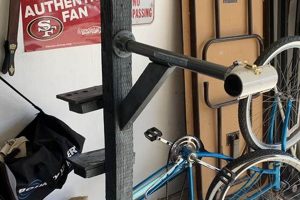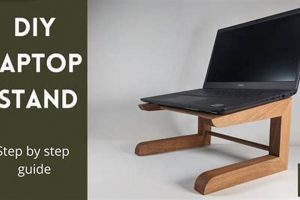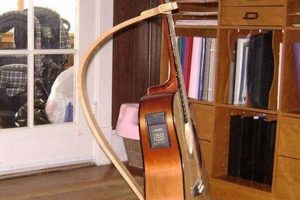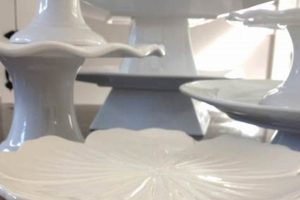A woodworking structure designed and built by an individual, not commercially manufactured, to support a power tool used for making precise angle cuts in wood is a practical addition to any workshop. This typically involves creating a stable platform for the cutting device, often incorporating features like extension wings for supporting longer workpieces, dust collection ports, and integrated measuring scales. An example would be a framed table constructed from lumber, with adjustable legs and a designated mounting surface for the power tool.
The advantages of such a project include cost savings compared to purchasing a pre-made, commercially available unit, customization options to suit specific workshop space constraints and workflow preferences, and the satisfaction derived from creating a functional tool support. Historically, these home-built solutions emerged as a response to the high cost and limited availability of purpose-built stands, allowing woodworkers to optimize their workspaces with tailored designs.
The following sections will examine various design considerations, material selection criteria, step-by-step construction methods, and safety precautions relevant to creating a functional and durable support structure for this type of power tool. Emphasis will be placed on optimizing the build for both portability and stability, ensuring a secure and efficient cutting experience.
Essential Considerations for Constructing a Miter Saw DIY Stand
This section provides critical guidelines for ensuring the successful fabrication of a durable and functional support structure for a miter saw. These recommendations address key aspects of design, material selection, and construction techniques.
Tip 1: Prioritize Stability. The design must incorporate a wide base and robust leg construction to minimize vibration and prevent tipping during operation. Cross-bracing is highly recommended to enhance rigidity.
Tip 2: Optimize Workpiece Support. Implement adjustable extension wings or rollers to adequately support longer pieces of material. This ensures accurate cuts and prevents material sag.
Tip 3: Integrate Dust Collection. Incorporate a dust port that can be connected to a shop vacuum or dust collection system. This significantly reduces airborne particulate matter and improves visibility.
Tip 4: Consider Portability. If mobility is a requirement, design the structure with folding legs or incorporate wheels for easy transportation and storage. Ensure locking mechanisms are robust and reliable.
Tip 5: Implement Accurate Measurement Aids. Integrate measuring scales or fences to facilitate precise and repeatable cuts. Ensure these aids are calibrated accurately.
Tip 6: Select Durable Materials. Utilize high-quality lumber or steel for construction. Consider moisture-resistant materials if the stand will be exposed to varying environmental conditions.
Tip 7: Ensure a Secure Mounting Platform. The surface on which the miter saw is mounted must be perfectly flat and securely fastened to the frame. This prevents movement and ensures cutting accuracy.
These considerations highlight the need for a well-planned and meticulously executed approach to building a miter saw support. Adherence to these guidelines will result in a safer, more efficient, and more enjoyable woodworking experience.
The following section will provide specific construction techniques and material recommendations to further refine the building process and ensure a high-quality finished product.
1. Stability
The stability of a self-constructed miter saw support is paramount to ensuring accurate cuts and operator safety. A rigid and immobile platform minimizes vibration and prevents movement during the sawing process, directly impacting the quality of the finished workpiece and reducing the risk of injury.
- Base Design and Footprint
A wider base provides increased resistance to tipping, especially when working with longer or heavier materials. Flared legs or the addition of outriggers can further enhance lateral stability. Insufficient base width can lead to dangerous instability, particularly when the saws center of gravity shifts during operation. This could cause the entire structure to tip, potentially damaging the saw, the workpiece, and causing injury to the operator.
- Material Selection and Rigidity
The choice of materials significantly impacts the overall stability of the stand. High-density lumber, such as hardwoods, or steel framing offer superior rigidity compared to softer woods like pine. Using undersized or low-quality materials can result in flexing and vibration, compromising cut accuracy and potentially leading to structural failure under load. Proper bracing and joinery techniques are also critical to maximize the stiffness of the chosen materials.
- Joint Construction and Fasteners
Robust joinery is essential for maintaining structural integrity. Mitered and reinforced joints, mortise-and-tenon joints, or strong mechanical fasteners like bolts and screws should be employed to connect the various components. Weak or poorly executed joints can loosen over time, leading to instability and wobble. Regular inspection and maintenance of the joints are necessary to ensure continued stability.
- Leveling and Surface Contact
Ensuring that the stand is level and that all feet are in firm contact with the floor is crucial for preventing rocking or wobbling. Adjustable feet allow for compensation for uneven surfaces. Failure to properly level the stand can result in inaccurate cuts and increased vibration, reducing the overall effectiveness of the support.
Each of these factors contributes to the overall stability of the miter saw support. A lack of attention to any one of these aspects can compromise the entire structure, leading to inaccurate cuts, increased vibration, and potential safety hazards. Prioritizing a stable design and employing robust construction techniques is therefore essential for creating a safe and effective workspace.
2. Material Cost
The selection of materials exerts a direct influence on the overall expense associated with constructing a miter saw support structure. The choice between lumber, steel, or composite materials significantly impacts the project’s financial demands. For instance, utilizing reclaimed lumber may substantially reduce costs compared to purchasing new, dimensioned lumber. Similarly, substituting steel framing for traditional wood construction may increase the initial outlay but offer enhanced durability and longevity, potentially offsetting the higher initial expense over time. Therefore, a careful evaluation of available materials and their associated prices is crucial in managing the project’s budget.
The design complexity and intended functionality also contribute to the material cost. A simple stand with basic support surfaces will require fewer materials and less intricate joinery compared to a more elaborate design incorporating features such as integrated dust collection, extension wings, or adjustable height mechanisms. Consider a project requiring portability; the inclusion of heavy-duty casters and locking mechanisms adds to the material costs. Conversely, simplifying the design to a stationary unit reduces the need for these components, thereby decreasing the overall expenditure. It is imperative to balance desired features with budgetary constraints, making informed decisions to optimize value.
Ultimately, material cost represents a significant determinant in the feasibility and accessibility of constructing a miter saw stand. Prudent planning, resourceful material sourcing, and a realistic assessment of required features contribute to minimizing expenses while ensuring the structure meets the user’s needs. The optimization of material selection, design, and function is central to a successful and cost-effective project.
3. Dust Control
The process of cutting wood with a miter saw generates a substantial quantity of fine particulate matter. This airborne dust poses a health hazard, potentially causing respiratory irritation and long-term lung damage with prolonged exposure. A self-constructed miter saw stand can incorporate features specifically designed to mitigate this dust production, contributing to a safer and healthier workshop environment. For example, a stand built with an enclosed back panel and a downward-facing dust port allows for the direct connection to a shop vacuum, capturing a significant portion of the dust at the source. Without such dust control measures, airborne particles disperse throughout the workspace, necessitating extensive cleanup and posing a continuous health risk.
The integration of effective dust management into the construction of a miter saw support is not merely an optional add-on, but a practical necessity. Beyond the health considerations, proper dust control enhances visibility, enabling more accurate cuts and reducing material waste. A clear line of sight to the workpiece is essential for precision, and excessive dust accumulation obscures markings and impedes the cutting process. Furthermore, the collection of sawdust simplifies workshop maintenance, reducing the time and effort required for cleaning. Examples include incorporating a sloped dust collection tray beneath the saw or utilizing a flexible hose connected to a high-efficiency particulate air (HEPA) filter.
In summary, the effective control of dust generated during miter saw operations is intrinsically linked to the design and construction of the support structure. Implementing dust collection ports, enclosures, and appropriate filtration systems minimizes health risks, improves visibility, and simplifies workshop maintenance. Neglecting this aspect can lead to long-term health consequences and a less efficient working environment. Thus, prioritizing dust control is a crucial element in creating a safe, productive, and sustainable woodworking space.
4. Work Support
The integration of adequate workpiece support is a critical factor in the design and construction of a miter saw stand. Insufficient support leads to inaccurate cuts, material waste, and potential safety hazards. Therefore, careful consideration must be given to incorporating features that effectively stabilize and secure the material being cut.
- Extension Wings and Adjustable Supports
Extension wings, typically constructed from wood or metal, provide a continuous and level surface extending outwards from the miter saw’s table. These wings support longer workpieces, preventing sagging or bowing that can distort the cut angle. Adjustable supports, such as rollers or flip-down brackets, allow for fine-tuning the height to match the saw table, ensuring a consistent plane of support. For example, when cutting long pieces of trim, extension wings prevent the material from drooping, which would result in an inaccurate miter joint.
- Material Clamping Systems
Clamping mechanisms offer enhanced stability by securing the workpiece to the stand. These systems can range from simple toggle clamps to more sophisticated pneumatic or vacuum-actuated devices. By firmly holding the material in place, clamping systems minimize vibration and prevent movement during the cutting process. This is particularly important when working with thin or flexible materials that are prone to shifting under the saw’s blade.
- Integrated Measuring and Stop Systems
Accurate measurements are essential for repeatable cuts. Integrating measuring scales and stop blocks into the miter saw support allows for consistent material lengths. Stop systems provide a physical barrier against which the workpiece can be positioned, ensuring that each piece is cut to the exact desired length. This eliminates the need for manual marking and measurement, saving time and reducing the risk of errors. An example is setting a stop block for cutting multiple pieces of lumber to the same length for a framing project.
- Outfeed Supports and Roller Stands
Outfeed supports, often consisting of adjustable roller stands positioned behind the miter saw, provide additional support for long workpieces as they exit the cutting area. These supports prevent the cut piece from dropping or shifting, which can lead to splintering or inaccurate cuts. Roller stands allow the material to glide smoothly, minimizing friction and ensuring a clean, precise cut. When working with exceptionally long boards, multiple outfeed supports may be necessary to maintain adequate stability.
These work support elements are fundamental to the successful operation of a miter saw and are integral to the design of an effective miter saw support. Integrating these features enhances accuracy, reduces material waste, and improves overall safety, ultimately contributing to a more efficient and productive woodworking experience.
5. Portability
The characteristic of mobility is a significant consideration in the design and construction of a self-assembled miter saw support. The ability to easily transport and relocate the power tool and its accompanying support structure offers considerable advantages in diverse work environments. This characteristic is particularly relevant for contractors operating on various job sites and hobbyists with limited or shared workshop spaces.
- Collapsible or Folding Designs
The incorporation of folding legs or a collapsible frame allows for a significant reduction in the footprint of the miter saw support during transport and storage. These designs often utilize hinges and locking mechanisms to provide both stability during operation and ease of disassembly for portability. An example is a stand with legs that fold inward and lock into a compact configuration, facilitating easy loading into a vehicle. This feature proves invaluable in situations where workspace is limited and frequent relocation is necessary.
- Integrated Wheel Systems
The addition of wheels, typically coupled with a handle, enables the miter saw support to be moved across a surface with minimal effort. The wheel system should be robust enough to withstand the weight of the saw and the support structure itself, and the wheels should ideally be lockable to prevent unwanted movement during use. A common implementation involves two fixed wheels and two swivel casters for enhanced maneuverability. Such a system is especially useful on construction sites where the tool must be moved frequently over uneven terrain.
- Weight and Material Selection
The choice of materials directly impacts the overall weight of the stand, influencing its portability. While heavier materials like steel offer increased stability, they also make the stand more difficult to transport. Lighter-weight materials, such as aluminum or certain types of engineered wood, provide a better balance between portability and structural integrity. An optimal design considers the trade-offs between weight, durability, and cost. For instance, an aluminum frame with composite work surfaces may offer a good compromise for a portable miter saw support.
- Modular Construction
Designing the miter saw support as a modular system, consisting of separate, easily detachable components, enhances portability. This approach allows the user to disassemble the stand into smaller, more manageable pieces for transport. Each module can be designed to be carried independently, reducing the overall weight burden. A common modular design might include a detachable saw mounting platform, separate extension wings, and a folding base frame. This system is particularly beneficial for individuals who frequently transport the miter saw support in a small vehicle or need to navigate stairs.
These facets highlight the diverse approaches to incorporating portability into a miter saw support. The selection of a particular design strategy depends on the specific needs and priorities of the user, including the frequency of transport, the type of work environment, and the available storage space. A well-designed portable miter saw support enhances productivity and efficiency by facilitating easy setup and relocation, regardless of the job site or workshop constraints.
6. Mount Security
The secure attachment of a miter saw to a self-constructed support structure is a foundational element of safe and accurate operation. Insufficient mount security compromises stability, increases vibration, and poses a significant risk of injury to the operator. The integrity of the mounting system directly influences the precision of cuts and the overall lifespan of both the saw and the stand.
- Fastener Selection and Placement
The choice of fasteners, including bolts, screws, and washers, dictates the strength and reliability of the connection between the saw and the stand. Fasteners must be of appropriate size and material to withstand the forces generated during operation. The correct placement of fasteners, adhering to the manufacturer’s specifications and utilizing a sufficient number of attachment points, is crucial for distributing the load evenly. For example, using undersized screws or neglecting to pre-drill pilot holes can result in stripped threads and a weakened mount. Conversely, employing high-strength bolts with lock washers and strategically placed through-holes provides a robust and secure connection. Failure to adhere to these principles can result in the saw detaching from the stand during operation, leading to potential injury and equipment damage.
- Platform Material and Thickness
The material and thickness of the platform onto which the miter saw is mounted directly affect the stability and security of the mount. Thin or flimsy materials, such as low-grade plywood, are prone to flexing and warping under the weight and vibration of the saw. Selecting a rigid material, such as hardwood or thick-gauge steel, provides a solid and stable base for the saw. The platform’s thickness should be sufficient to accommodate the selected fasteners without compromising its structural integrity. For instance, mounting a heavy miter saw on a thin plywood platform with short screws will inevitably lead to a weakened mount and potential failure. Using a thick hardwood platform with appropriately sized bolts ensures a secure and stable connection.
- Vibration Dampening Measures
Vibration generated during miter saw operation can gradually loosen fasteners and weaken the mount over time. Incorporating vibration dampening measures, such as rubber pads or isolating mounts, minimizes the transmission of vibration to the stand. These measures help to maintain the integrity of the mounting system and extend the lifespan of both the saw and the stand. An example would be placing rubber washers between the saw’s base and the mounting platform to absorb vibration. Neglecting to implement vibration dampening can result in premature wear and tear on the mounting system, leading to instability and potential failure.
- Regular Inspection and Maintenance
Periodic inspection of the mounting system is essential for identifying and addressing potential issues before they escalate. Fasteners should be checked for tightness and signs of corrosion. The platform should be examined for cracks or warping. Any signs of wear or damage should be addressed promptly. For example, loose bolts should be tightened, damaged fasteners should be replaced, and cracked platforms should be repaired or replaced. Neglecting regular inspection and maintenance can result in a gradual degradation of the mounting system, ultimately compromising its security and leading to potential safety hazards.
These considerations underscore the critical importance of mount security in the design and construction of a self-built miter saw support. Prioritizing a robust and well-maintained mounting system ensures safe and accurate operation, extending the lifespan of the equipment and protecting the operator from potential injury. The inherent stability of the attachment between the saw and the stand is the linchpin to effective cutting.
Frequently Asked Questions
This section addresses common inquiries concerning the design, construction, and utilization of self-built miter saw support structures. The following questions and answers provide practical guidance for optimizing the effectiveness and safety of these woodworking accessories.
Question 1: What materials are most suitable for constructing a durable miter saw support?
High-density lumber, such as hardwoods like oak or maple, provides excellent rigidity and resistance to wear. Steel framing offers superior strength and longevity, but typically requires welding skills. Engineered wood products, such as plywood or MDF, can be used for non-structural components but must be of sufficient thickness to prevent flexing.
Question 2: How can stability be maximized in a self-constructed miter saw support?
A wide base with robust leg construction is essential. Cross-bracing between the legs and along the frame provides additional rigidity. Adjustable feet allow for leveling on uneven surfaces. The mounting platform must be securely fastened to the frame to prevent movement.
Question 3: What are effective methods for integrating dust collection into a miter saw stand?
An enclosed back panel with a downward-facing dust port connected to a shop vacuum is highly effective. A sloped dust collection tray beneath the saw can capture falling debris. Sealing gaps and crevices around the saw mounting area minimizes dust escape.
Question 4: How can adequate workpiece support be provided for longer materials?
Extension wings extending outwards from the saw table provide continuous support. Adjustable rollers or flip-down brackets allow for fine-tuning the height to match the saw table. Outfeed supports positioned behind the saw prevent cut pieces from dropping or shifting.
Question 5: What design features facilitate portability in a miter saw support?
Folding legs or a collapsible frame significantly reduce the footprint during transport. Integrated wheel systems, coupled with a handle, enable easy movement. Modular construction, with detachable components, allows for disassembly into smaller, more manageable pieces.
Question 6: How can the miter saw be securely mounted to the support structure?
Appropriately sized bolts, screws, and washers should be used to fasten the saw to the platform. The platform material must be sufficiently thick and rigid to prevent flexing. Vibration dampening measures, such as rubber pads, minimize vibration transmission. Regular inspection and maintenance ensure the integrity of the mounting system.
In summary, the construction of a functional and safe miter saw support structure requires careful consideration of materials, design features, and assembly techniques. Proper attention to stability, dust collection, workpiece support, portability, and mount security ensures a productive and enjoyable woodworking experience.
The subsequent section will explore advanced design considerations and customization options for tailoring a miter saw support to specific needs and preferences.
Concluding Remarks on Miter Saw DIY Stand Construction
This exploration has detailed the critical aspects of constructing a miter saw DIY stand, emphasizing stability, material selection, dust control, workpiece support, portability, and secure saw mounting. A comprehensive understanding of these elements is paramount for ensuring a safe, efficient, and accurate woodworking operation. The benefits of a well-designed and constructed stand extend beyond mere convenience, directly impacting the quality of finished projects and the longevity of the power tool.
The information provided serves as a foundation for informed decision-making in the creation of a customized support structure. Woodworkers are encouraged to apply these principles, adapting designs to meet individual workshop needs and project requirements. Continued attention to safety and maintenance will ensure the sustained utility and value of the miter saw DIY stand, contributing to a productive and fulfilling woodworking pursuit.







